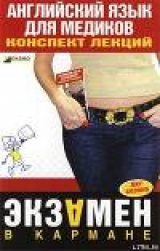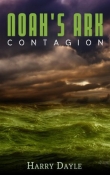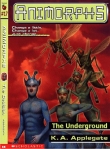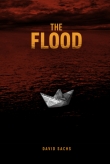
Текст книги "Английский язык для медиков: конспект лекций"
Автор книги: Елена Беликова
Жанры:
Языкознание
,сообщить о нарушении
Текущая страница: 6 (всего у книги 12 страниц)
ЛЕКЦИЯ № 18. Arteries
Arteries are classified according to their size, the appearance of their tunica media, or their major function.
Large elastic conducting arteries include the aorta and its large branches. Unstained, they appear yellow due to their high con tent of elastin.
The tunica intima is composed of endothelium and a thin sub jacent connective tissue layer. An internal elastic membrane marks the boundary between the intima and media.
The tunica media is extremely thick in large arteries and con sists of circularly organized, fenestrated sheets of elastic tissue with interspersed smooth muscle cells. These cells are responsi ble for producing elastin and other extracellular matrix com ponents. The outermost elastin sheet is considered as the external elastic membrane, which marks the boundary between the media and the tunica adventitia.
The tunica adventitia is a longitudinally oriented collection of colla-genous bundles and delicate elastic fibers with associated fibroblasts. Large blood vessels have their own blood supply (vasa vasorum), which consists of small vessels that branch profusely in the walls of larger arteries and veins. Muscular distributing arteries are medium-sized vessels that are characterized by their predominance of circularly arranged smooth muscle cells in the media interspersed with a few elastin compo nents. Up to 40 layers of smooth muscle may occur. Both internal and external elastic limiting membranes are clearly demonstrated. The intima is thinner than that of the large arteries.
Arterioles are the smallest components of the arterial tree. Generally, any artery less than 0,5 mm in diameter is considered to be a small artery or arteriole. A subendothelial layer and the inter nal elastic membrane may be present in the largest of these vessels but are absent in the smaller ones. The media is composed of sev eral smooth muscle cell layers, and the adventitia is poorly devel oped. An external elastic membrane is absent.
New words
arteries – артерии
to be classified – классифицированный
according – соответственно
their – их
size – размер
appearance – вид
tunica – оболочка
major – главный
elastic – упругий
conducting – проведение
arteries – артерии
to include – включать
aorta – аорта
branches – ветви
up to – до
layers – слои
smooth – гладкий
may – может
Запомните следующие застывшие словосочетания.
In a loud voice In a low voice In an angry voice In a thin voice
Заполните пропуски, где необходимо.
1. She shouted in. low voice.
2. He told us the poem in. loud voice.
3. The children asked ice-cream in. thin voice.
4. The teacher cried at the pupils in. angry voice.
5. Bill Robins was… very rich man.
6. He was. richest man in. village.
7. Pete is… tallest boy in our class.
8. Nick is… shortest boy, but he is very strong.
9. He is… stronger than many boys who are taller than he.
10. I think Nick is… strongest boy in class.
Перед превосходной степенью прилагательных употребляется определенные артикль.
E. g. Asia is the largest continent.
My brother is the best pupil in his class.
Вставьте артикль, где необходимо.
1. Bill Robins was… very rich man. He was… richest man in… village.
2. Pete is… tallest boy in our class. Nick is… shortest boy, but he is very strong.
3. He is… stronger than many boys who are taller than he.
4. I think Nick is… strongest boy in class.
5. Granny often tells us… long stories. Today her story was still… longer.
6. It was… longest story. She began telling it after… dinner and finished it before… supper.
7. But… story was very interesting. I think it was… most interesting of Granny's stories.
8. Which was… most difficult exercise in. test-paper?
9. Which is… best season of the yea?
10. February is… shortest month of the year.
Answer the questions.
1. How are arteries classified?
2. What do large elastic conducting arteries include?
3. What is the tunica intima composed of?
4. What does an internal elastic membrane mark?
5. Is the tunica media thick?
6. Is the tunica adventitia a longitudinally oriented collection of col-lagenous bundles?
7. With what do the tunica adventitia associated?
8. What are muscular distributing arteries?
9. Up to how many layers of smooth muscle may occur?
10. What is the media composed of?
Make the sentences of your own using the new words (10 sentences).
Find the definite and indefinite articles in the text.
ЛЕКЦИЯ № 19. Capillaries
Capillaries are thin-walled, narrow-diameter, low-pressure vessels that generally permit easy diffusion across their walls. Most capillar ies have a cross-sectional diameter of 7-12 mm. They are composed of a simple layer of endothelium, which is the lining of the entire vas cu-lar system, and an underlying basal lamina. They are attached to the surrounding tissues by a delicate reticulum of collagen. Associated with these vessels at various points along their length are specialized cells called pericytes. These cells, enclosed within their own basal lamina, which is continuous with that of the endothelium, contain contractile proteins and thus may be involved in the control of capillary dynamics. They may also serve as stem cells at times of vascular repair. Capillaries are generally divided into three types, according to the structure of their endothelial cell walls.
Continuous (muscular, somatic) capillaries are formed by a single uninterrupted layer of endothelial cells rolled up into the shape of a tube and can be found in locations such as connective tissue, muscle, and nerve.
Fenestrated (visceral) capillaries are characterized by the presence of pores in the endothelial cell wall. The pores are covered by a thin diaphragm (except in the glomeruli of the kidney) and are usually encountered in tissues where rapid substance interchange occurs (e. g., kidney, intestine, endocrine glands).
Sinusoidal capillaries can be found in the liver, hematopoietic and lymphopoietic organs, and in certain endocrine glands. These tubes with discontinuous endothelial walls have a larger diame ter than other capillaries (up to 40 mm), exhibit irregular cross-sec tional profiles, have more tortuous paths, and often lack a con tinuous basal lamina. Cells with phagocytic activity (macrophages) are present within, or just subjacent to, the endothelium.
New words
capillaries – капилляры
to thin-walled – окруженный тонкой стеной
narrow-diameter – узкий диаметр
low-pressure – низкое давление
that – тот
generally – главным образом
permit – разрешение
easy – легкий
diffusion – распространение
cross-sectional – поперечный
to be composed – быть составленным
simple – простой
endothelium – эндотелий
lining – выравнивание
entire – весь
vas cular – сосудистый
underlying – лежащий в основе
basal – основной
lamina – тонкая пластинка
Правила употребления артикля с географическими названиями.
Определенный артикль употребляется перед названиями рек, каналов, морей, заливов, проливов, океанов, архипелагов, горных цепей.
Артикль не употребляется перед названиям озер, гор, островов, континентов, городов, стран. Исключения:
the United States of America
the United Kingdom of Great Britain and Northern Ireland the Netherlands the Ukraine the Crimea the Congo
Answer the questions.
1. Describe capillaries: how do they like?
2. What diameter do the most capillaries have?
3. What are the capillaries composed of?
4. Where are the capillaries attached to?
5. What are pericytes?
6. What do pericytes contain?
7. Where can pericytes be involved?
8. Where can sinusoidal capillaries be found?
9. What diameter have sinusoidal capillaries?
10. With help of what are continuous (muscular, somatic) capillaries formed by?
Make the sentences of your own using the new words (10 sentences).
Find the definite and indefinite articles in the text.
ЛЕКЦИЯ № 20. Veins
Veins are low-pressure vessels that have larger lumina and thinner walls than arteries. In general, veins have more collagenous connec ti-ve tissue and less muscle and elastic tissue than their arterial coun ter-parts. Although the walls of veins usually exhibit the three layers, they are much less distinct than those of the arter ies. Unlike arteries, veins contain one-way valves composed of exten sions of the intima that prevent reflux of blood away from the heart. Veins can be divided into small veins or venules, medium veins, and large veins.
Venules are the smallest veins, ranging in diameter from approxi mately 15-20 mm (post-capillary venules) up to 1-2 mm (small veins). The walls of the smaller of these are structurally and func tio-nally like those of the capillaries; they consist of an endothelium surrounded by delicate collagen fibers and some pericytes. In those vessels of increased diameter, circularly arranged smooth muscle cells occur surrounding the intima layer, but unlike in the small arteries, these cells are loosely woven and widely spaced. Venules are important in inflammation because their endothelial cells are sensitive to his-tamine released by local mast cells. This causes endothelial cells to contract and separate from each other, exposing a naked basement membrane. Neutrophils stick to the exposed collagen and extravasate (i. e., move out into the connective tissue). Histamine also causes local arterioles to relax, affect ing a rise in venous pressure and increased leaking of fluid. This produces the classic signs of inflammation: redness, heat, and swelling.
Medium veins in the range of 1-9 mm in diameter have a well – developed intima, a media consisting of connective tissue and loosely organized smooth muscle, and an adventitia (usually the thickest layer) composed of collagen bundles, elastic fibers, and smooth muscle cells oriented along the longitudinal axis of the vessel. Venous valves are sheet-like outfoldings of endothelium and underlying connective tissue that form flaps to permit unidi rectional flow of blood.
Large veins, such as the external iliac, hepatic portal, and vena ca-vae, are the major conduits of return toward the heart. The intima is similar to that of medium veins. Although a network of elastic fibers may occur at the boundary between the intima andmedia, a typical internal elastic membrane as seen in arteries is not present. A tunica media may or may not be present. If pre sent, smooth muscle cells are most often circularly arranged. The adventitia is the thickest layer of the wall and consists of elastic fibers and longitudinal bundles of collagen. In the vena cava, this layer also contains well-developed bundles of longitudinally oriented smooth muscle.
New words
vein – вена
low-pressure – низкое давление
to have – иметь
collagenous – коллагеновый
elastic – упругий
although – хотя
walls – стенкы
coun terparts – копии
unlike – в отличие от
exten sions – расширения
intima – интима
to prevent – предотвратить
reflux – рефлюкс
sheet-like – подобный листу
inflammation – воспламенение
because – потому что
longitudinal – продольный
flaps – откидные створки
external – внешний
iliac – подвздошный
hepatic – печеночник
Запомните следующие застывшие словосочетания:
To have a good time From _ morning till night All _ day long
A lot of
Перед названиями университетов артикль не употребляется.
E. g. I shall study at _ St. Petersburg University.
My grandfather graduated from _ Oxford University
Вставьте артикль, где необходимо.
1. Did you have… good time in the country?
2. Oh yes… weather was fine.
3. We were out of… doors from… morning till… night.
4. We played… football,… volley-ball and… other games.
5. We саше… home late at… night and went to… bed at once.
6. Look at… clock! It is… quarter past ten. Go to… bed at once.
7.. sun rises in.east and sets in. west.
8. We spent last summer in. Ukraine.
9. We often went to. wood and gathered lot of… mushrooms.
10. My friend likes to play… chess. He is ready to play… chess all… day long.
11. Willi comes from… very old country on… Nile. It is called… Ethiopia.
12… Ethiopia is… beautiful mountainous country.
13. Nick is… young man. He wants to become… engineer.
14. Very often in… evening his new friends and he walk about… city talking about their native countries.
15. Marina lives in. Ukraine.
16. She lives in… small village near… Kiev.
17. She is… librarian. In summer she has… lot of work work.
18. I want to enter. Moscow University.
19. My Friend lives in… America
20. He studies Indies… history at… Harvard University.
Answer the questions.
1. What are veins?
2. In general do veins have more collagenous connec tive tissue?
3. Do veins have less muscle and elastic tissue than their arterial coun terparts?
4. What valves do veins contain?
5. How veins can be divided?
6. How much the venules are long?
7. Where are venules important?
8. Where do neutrophils stick to?
9. What do contain medium veins?
10. What are the major conduits of return toward the heart?
Make the sentences of your own using the new words (10 sentences).
Find the definite and indefinite articles in the text.
ЛЕКЦИЯ № 21. Heart
The heart is a muscular organ, composed primarily of cardiac muscle tissue, which contracts rhythmically to pump blood throughout the body. Structure of the heart wall: the walls of the heart are constructed in layers that are similar to those of the major blood vessels.
Endocardium is the innermost layer of the heart and is lined with endothelium. Veins, nerves, and components of the impulse conducting system are present in the subendocardial connective tissue layer.
Myocardium is composed of branching, anastomotic cardiac myocytes attached to one another by intercalated disks. Most of these cells are involved in the pumping function of the heart; others are specialized for the control of rhythmicity (impulse conducting system) or secretion (myocardial endocrine cells).
Epicardium is a serous membrane that forms the visceral lining of the pericardium. Its external mesothelium is supported by a loose connective tissue subepicardial layer.
Cardiac skeleton is composed mainly of dense connective tissue and consists of the annuli fibrosi, the trigonum fibrosum, and the septum membranaceum.
Cardiac valves are composed of dense fibrous tissue covered by endothelium. Unidirectional flow is maintained from the.
Right atrium to the right ventricle (tricuspid valve).
Right ventricle to the pulmonary artery (pulmonic semilunar valve). Left atrium to the left ventricle (mitral/bicuspid valve).
Left ventricle to the aorta (aortic semilunar valve).
Tricuspid and mitral valves are attached to papillary muscles by cords of fibrous connective tissue (chordae tendineae) and prevent reflux of blood into the atria during ventricular con traction (systole). Semilunar valves (aortic and pulmonic) prevent reflux of blood back into the ventricles during ventricular relaxation (diastole).
Impulse conducting system of the heart consists of specialized cardiac myocytes that are characterized by automaticity and rhythmicity (i. e., they are independent of nervous stimulation and possess the ability to initiate heart beats). These specialized cells are located in the si-noatrial (SA) node (pacemaker), intern-odal tracts, atrioventricular (AV) node, AV bundle (of His), left and right bundle branches, and numerous smaller branches to the left and right ventricular walls. Impulse conduct ing myocytes are in electrical contact with each other and with normal contractile myocytes via communicating (gap) junctions. Specialized wide-diameter impulse conducting cells (Purkinje myocy-tes), with greatly reduced myofilament components, are well-adapted to increase conduction velocity. They rapidly deliver the wave of depolarization to ventricular myocytes.
New words
heart – сердце
muscular – мышечный
cardiac – сердечный
which – который
contract – контракт
rhythmically – ритмично
to pump – качать
endocardium – эндокардиум
innermost – самый внутренний
components – компоненты
conducting system – проведение системы
to present – представлять
subendocardial – внутрисердечный
impulse – импульс
fibrosi – фиброзные кольца
Запомните следующие застывшие словосочетания.
What's the use?
At the cinema
At the theatre
At the shop
At the market
To the cinema
To the theatre
To the shop
To the market
To go for a walk
Вставьте артикль, где необходимо.
1. Once there lived… man who was very fond of fold.
2. He used to say: «While I have my gold, I am… happiest man in… world».
3. And so all his life saved… money.
4. One day he was traveling in… desert of… North Africa.
5. He lost his way.. He had no… food or… water.
6. He was almost dying of… hunger.
7.. heat was terrible.
8. There were only… stones and… sand around.
9. What is. use of gold?
10. Let's go to… shop. I must buy… bread and milk.
11. I was at… cinema yesterday.
12. What. film did you see?
13. Oh, I saw… very good film.
14. Ithink it is… best film of… year.
15. Do you oft go to… theatre?
16. No, I don't. I like to go to. theatre, but I. very busy.
17. I work from… morning till… night.
18. I even have no… time to play piano.
19… lot of… tourists from… different countries come to… Paris.
Answer the questions.
1. What is the muscular organ?
2. What is heart primarily composed of?
3. What is the structure of the heart wall?
4. What is endocardium?
5. With what is endocardium lined?
6. What are present in the subendocardial connective tissue layer?
7. What is myocardium composed?
8. What is cardiac skeleton composed of?
9. What are cardiac valves composed of?
10. What do rapidly deliver the wave of depolarization to ventricular myocytes?
Make the sentences of your own using the new words (10 sentences).
Find the definite and indefinite articles in the text.
ЛЕКЦИЯ № 22. Lungs
Intrapulmonary bronchi: the primary bronchi give rise to three main branches in the right lung and two branches in the left lung, each of which supply a pulmonary lobe. These lobar bronchi divide repeatedly to give rise to bronchioles.
Mucosa consists of the typical respiratory epithelium and an underlying lamina propria similar to that of the trachea. However, a layer of loosely woven smooth muscle (muscularis mucosae), which separates the lamina propria from the submucosa, is present.
Submucosa consists of elastic tissue with fewer mixed glands than seen in the trachea.
Anastomosing cartilage plates replace the C-shaped rings found in the trachea and extra pulmonary portions of the pri mary bronchi. These plates become progressively smaller asairway diameter decreases.
Bronchioles do not possess cartilage, glands, or lymphatic nodules; however, they contain the highest proportion of smooth r muscle in the bronchial tree. Bronchioles branch up to 12 times to supply lobules in the lung, which are bounded by connective tis sue septa. The smallest conducting bronchioles are called terminal bronchioles.
Bronchioles are lined by ciliated, simple, columnar epithelium with nonciliated bronchiolar (Clara) cells. Goblet cells are pre sent in large bronchioles. A smooth muscle layer interlaces the elastic fibers of the lamina propria. The musculature of the bronchi and bronchioles con tracts following stimulation by parasympathetic fibers (vagus nerve) and relaxes in response to sympathetic fibers. Terminal bronchioles consist of low-ciliated epithelium with bronchiolar cells.
The costal surface is a large convex area related to the inner surface of the ribs.
The mediastinal surface is a concave medial surface.
The left lung has a deep cardiac impression.
The mediastinal surface contains the root, or hilus, of the lung.
The pulmonary ligament is a double fold of pleura hanging inferior to the root of the lung.
The diaphragmatic surface (base) is related to the convex sur face of the diaphragm. It is more concave on the right due to the presence of the liver. The apex (cupola) protrudes into the root of the neck. It is crossed by the subclavian artery anteriorly.
The hilus is the point of attachment for the root of the lung. It contains the bronchi, pulmonary and bronchial vessels, lym phatics, and nerves. Lobes and fissures.
The right lung is divided by the oblique and horizontal fissures into three lobes: superior, middle and inferior.
The left lung has only one fissure, the oblique, which divides the lung into upper and lower lobes. The lingula of the upper lobe corresponds to the middle lobe of the right lung.
Bronchopulmonary segments of the lung are supplied by the seg-mental (tertiary) bronchus, artery, and vein. There are 10 on the right and 8 on the left.
Arterial supply: Right and left pulmonary arteries arise from the pulmonary trunk. The pulmonary arteries deliver deoxygenated blood to the lungs from the right side of the heart.
Bronchial arteries supply the bronchi and nonrespiratory por tions of the lung. They are usually branches of the thoracic aorta.
Venous drainage. There are four pulmonary veins: superior right and left and inferior right and left. Pulmonary veins carry oxygenated biblood to the left atrium of the heart.
The bronchial veins drain to the azygos system. They share drainage from the bronchi with the pulmonary veins.
Lymphatic drainage: Superficial drainage is to the bronchopulmo-nary nodes; from there, drainage is to the tracheobronchial nodes.
Deep drainage is to the pulmonary nodes; from there, drainage is to the bronchopulmonary nodes.
Bronchomediastinal lymph trunks drain to the right lymphatic duct and the thoracic duct.
Innervation of Lungs: Anterior and posterior pulmonary plexuses are formed by vagal (parasympathetic) and sympathetic fibers. Para-sympathetic stimulation has a bronchoconstrictive effect. Sympathetic stimulation has a bronchodilator effect.
New words
lungs – легкие
intrapulmonary bronchi – внутрилегочные бронхи
the primary bronchi – первичные бронхи
to give – давать
to rise – повышать
lobar bronchi – долевые бронхи
to divide – разделять
repeatedly – неоднократно
loosely – свободно
woven – сотканный
smooth – гладкий
submucosa – подслизистая оболочка
costal – реберный
surface – поверхность
onvex – выпуклый
apex – вершина
to protrude – высовываеться
superior – выше
right – право
left – оставленный
inferior – низший
innervation – иннервация
Образование множественного числа существительных:
a cat – cats
a dog – dogs
а саr – cars
a watch – watches
a dress – dresses
a dish – dishes
a box – boxes
a potato – potetos
Запомните форму множественного числа следующих существительных:
a goose – geese
a tooth – teeth
a foot – feet
an ox – oxen
a man – men
a woman – women
a child – children
a mouse – mice
А также:
an englishman – englishmen
a frenchman – frenchmen
a german – germans
Существуют существительные, имеющие во множественном числе ту же форму, что и в единственном:
a sheep – sheep
a deer – deer
a swine – swine
Поставьте следующие существительные во множественное число.
A park, a play, a table, a plate, a fox, a room, a lady, a knife, a hair, a bus, a match, a way, a house, a family, a flag, a town, a wolf, a country, a lion, a star, a mountain, a tree, a shilling, a king, the waiter, the queen, a man, the man, a woman, the woman, an eye, a shelf, a box, the city, a boy, a goose, the watch, a mouse, a dress, a toy, the sheet, a tooth, a child, the ox, a deer, the life, a tomato.
This tea-cup, this egg, that wall, that picture, this foot, that mountain, this lady, that window, this man, that match, this knife.
Answer the questions.
1. What do the primary bronchi give?
2. For how many main branches in the right lung give primary bronchi rise?
3. For how many main branches in the left lung give primary bronchi rise?
4. What for lobar bronchi divide repeatedly?
5. What does mucosa consist of?
6. What is submucosa consist of?
7. What lung has a deep cardiac impression?
8. Where is the diaphragmatic surface (base) related?
9. How many pulmonary veins are there?
10. How are anterior and posterior pulmonary plexuses formed by?
Make the sentences of your own using the new words (10 sentences).
Find the definite and indefinite articles in the text.








